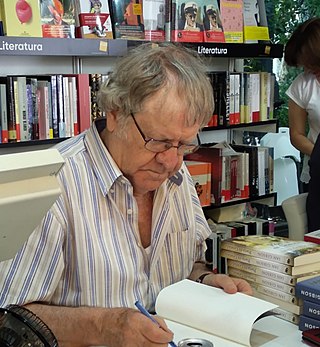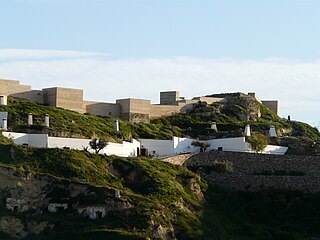
Federico del Sagrado Corazón de Jesús García Lorca was a Spanish poet, playwright, and theatre director. García Lorca achieved international recognition as an emblematic member of the Generation of '27, a group consisting mostly of poets who introduced the tenets of European movements into Spanish literature.
Cante jondo is a vocal style in flamenco, an unspoiled form of Andalusian folk music. The name means "deep song" in Spanish, with hondo ("deep") spelled with J as a form of eye dialect, because traditional Andalusian pronunciation has retained an aspirated H lost in other forms of Spanish.

Ian Gibson is an Irish author and Hispanist known for his biographies of the poet Antonio Machado, the artist Salvador Dalí, the bibliographer Henry Spencer Ashbee, the filmmaker Luis Buñuel. and particularly his work on the poet and playwright Federico García Lorca, for which he won several awards, including the 1989 James Tait Black Memorial Prize for biography. His work, La represión nacionalista de Granada en 1936 y la muerte de Federico García Lorca was banned in Spain under Franco.
Emilio García Gómez, 1st Count of Alixares was a Spanish Arabist, literary historian and critic, whose talent as a poet enriched his many translations from Arabic.

Alfacar is a historic town approximately 8 kilometres (5.0 mi) from the city of Granada, in the autonomous Spanish region of Andalucia. In the 2005 census, INE reported its population as 5107 inhabitants. The town is on the edge of the Sierra de Huétor Natural Park and is in a region of intensive olive production. The town is 920 metres (3,020 ft) above sea level, but the local fossil record contains marine molluscs that show the profound geological forces that have shaped the region.

Candeleda is a town and municipality located in the province of Ávila, in the autonomous community of Castile and León, Spain. According to the 2011 INE census, the municipality has a population of 5,213 inhabitants, making it the fifth largest municipality in the province after Ávila –the capital–, Arévalo, Arenas de San Pedro and Las Navas del Marqués. The town is located on the southern hillside of the Gredos mountains, 432 m above sea level, giving it a microclimate with a thermal regime of mild winters and hot summers and average summer temperatures of 26 °C.

Puerto Lumbreras is a Spanish municipality in the autonomous community of Murcia. It has a population of 15,780 (2020) and an area of 139 km2. It is located in the southwestern end of Region of Murcia and is adjacent to Andalusia.
Luis Rosales Camacho was a Spanish poet and essay writer member of the Generation of '36.

Juan Ignacío Cazador Sakho, known as Juan (el) Cazador was a Spanish poet and artist of Spanish and Senegalese origin. He was born in the village of Acequías, Granada on the edge of the Sierra Nevada.
Sultana Wahnón Bensusan is a Spanish essayist and literary critic, a professor at the University of Granada specializing in literary theory and comparative literature.
María Dolores García Cotarelo is a Spanish politician. First involved with a clandestine socialist organization back in 1975, she went on to become the Deputy Mayor of Culture of the City Hall of Granada and was charged with insulting religion. She continued to be involved in party politics in 2017, and was honored in 2018 as one of eleven women who helped bring democracy to Granada.

Gloria Giner de los Ríos García was a Spanish teacher at the Escuela Normal Superior de Maestras and the Institución Libre de Enseñanza. The author of innovative manuals dedicated to the teaching of history and geography, she, together with Leonor Serrano Pablo, developed the educational "recipe" that they called "enthusiastic observation". They also worked to change the androcentric canon of geographical studies to include women.

José Val del Omar was a Spanish photographer, film director and inventor.
Juan Ramírez de Lucas (1917–2010) was a Spanish writer and journalist, who, after his death in 2010, was revealed to have been the lover of Spanish poet and playwright Federico García Lorca. It was for Ramírez that the poet wrote his last collection, Sonetos de amor oscuro, completed in 1936 shortly before his assassination by a Nationalist militia.

The Casa-Museo Federico García Lorca, better known as Huerta de San Vicente, was the García Lorca family's historical summer home, from 1926 to 1936.

Daniel Doura is an Argentine composer of classical music. Considered one of the Argentine composers who currently have international exposure, Doura is a graduate of the Boston Conservatory, the Massachusetts Institute of Technology and the University of Columbia, and among his teachers were John Cage, Mario Davidovsky, Chou Wen-chung, Alberto Ginastera, Luciano Berio, Tōru Takemitsu, Milton Babbitt and John Adams, among others. He received the Best Composition award from the American Society of Composers, Authors and Publishers (ASCAP) in 1985 and was a finalist for the Best Composition award from the American Academy of Arts and Sciences (AAA&S).
A number of works have been based on, have been inspired by, or have alluded to the works of Spanish poet, playwright, and theatre director Federico del Sagrado Corazón de Jesús García Lorca.
Emilio Aladrén Perojo was a Spanish sculptor.













